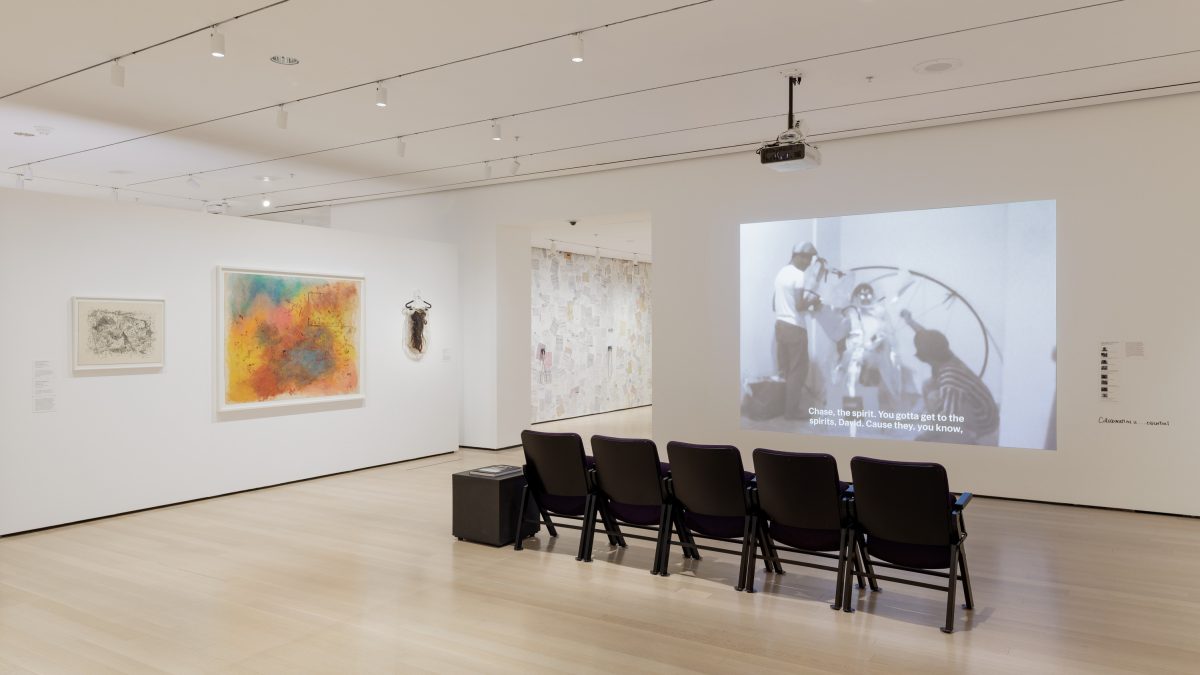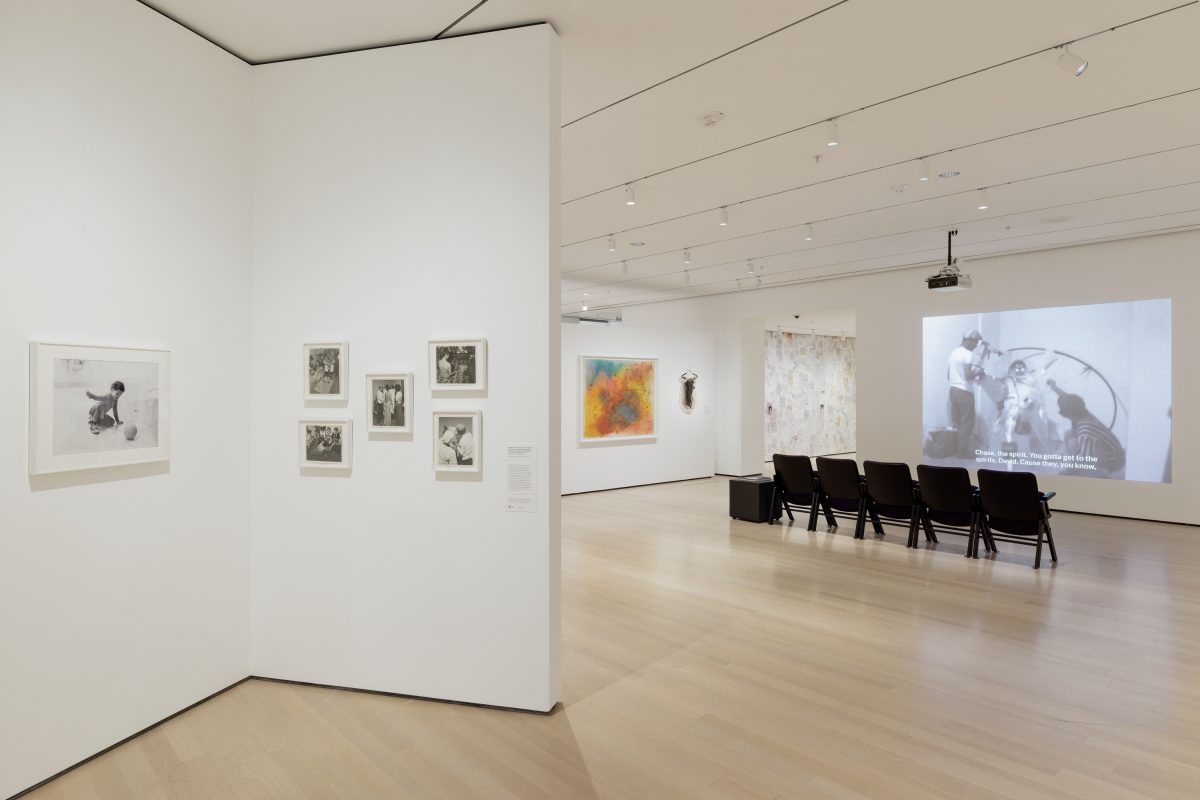
- This event has passed.
The Museum of Modern Art presents Just Above Midtown: Changing Spaces from October 9, 2022, through February 18, 2023, across the third floor Edward Steichen Galleries. Just Above Midtown (JAM) was an art gallery and Black space that welcomed artists and visitors of many generations and races in New York City from 1974 until 1986. A hub for Conceptual art, abstraction, performance, and video, JAM expanded the idea of Black art and encouraged both critiques of and thinking beyond the commercialization of art. Linda Goode Bryant started JAM in 1974, when she was a 25-year-old arts educator and mother of two, to, in her words, “present African-American artists on the same platform with other established artists.” A self-declared laboratory for experimentation, JAM encouraged artists and visitors to challenge hierarchies within the art world and definitions of what art should be.
MoMA’s exhibition follows a loose chronological structure that references the hundreds of solo and group exhibitions, performances, and installations at JAM. The display will include a wide range of art made by key figures like David Hammons, Janet Henry, Senga Nengudi, Lorraine O’Grady, Howardena Pindell, and Randy Williams, among many others. The exhibition presents archival photos, videos, and other contextual historical material to give visitors a sense of the collaborative ethos that defined the art gallery and the alternative model of art it championed to respond to a society in need. In addition to the exhibition, the project includes performances, film screenings, public programs, and an exhibition catalogue, co-published with The Studio Museum in Harlem. Just Above Midtown: Changing Spaces is organized by Thomas (T.) Jean Lax, Curator, with Lilia Rocio Taboada, Curatorial Assistant, Department of Media and Performance, in collaboration with Linda Goode Bryant and Marielle Ingram. With thanks to Amber Edmond, Brandon Eng, Curatorial Fellows, and Argyro Nicolau, former 12-month Intern, Media and Performance.
Thomas (T.) Jean Lax explains, “This exhibition recognizes Just Above Midtown as the efflorescent space that modeled how art and the relationships art fosters could respond to a society in crisis. This ambitious project not only historicizes JAM’s importance, but also underscores its relevance in the present.”
MoMA’s exhibition opens with archival materials that introduce Goode Bryant and JAM to visitors, alongside select artworks that capture the art gallery’s belief in using unconventional and found materials and show the range of styles seen in over 150 JAM exhibitions between 1974 and 1986. Works like Sydney Blum’s SWARMS four (1980), Randy Williams’s L’art abstrait (1977), Valerie Maynard’s The Artist Trying to Get It All Down (c. 1970), and Wendy Ward Ehlers’s Untitled (Three Inches Equals One Week of Laundry) (c. 1974) are presented in tandem with archival documents and photographs from JAM’s opening alongside video footage of Goode Bryant. The interplay of artwork and archive, which visitors experience throughout the exhibition, invites audiences to explore how JAM brought together a community that shared a powerful belief in the ability of artists to use what they had to create what they needed, and to support each other.
The next section of the MoMA exhibition offers a deeper focus on the more than 50 exhibitions that JAM organized from 1974 through 1979. These exhibitions were shown at the gallery’s first location at 50 West 57th Street, which was situated in the commercial art gallery district of New York City that was dominated by white gallerists, artists, and buyers. Works on view connect to emblematic group shows at JAM, including its inaugural exhibition, Synthesis: A combination of parts or elements into a complex whole, which presented for the first time Vivian Browne’s painting Untitled (Man in Mountain) (1974) and Norman Lewis’s No. 2 (1973). Synthesis offered a vision of Black art that included and celebrated both figuration and abstraction—a radical departure, at the time, from the broader art world’s status quo of separating those two practices. Visitors also see the pairing of David Hammons’s Untitled (1976) and Jasper Johns’s Hatteras (1963), referencing the show Statements Known and Statements New. This landmark 1976 JAM exhibition juxtaposed works on paper by five widely recognized white artists with works by less established artists of color, to emphasize the importance of creating a desegregated Black space in which non-Black artists show their work, too. The publication Contextures, authored by Goode Bryant and art historian Marcy S. Phillips in 1978, is on view, as well. In Contextures, Goode Bryant and Phillips combined the words “context” and “texture” to create a new concept that referenced artists who questioned the inherent properties of art and used found and remaining materials to create new works of art, while maintaining the integrity of their original form. A loop of archival footage, produced by Randy Williams and Goode Bryant, provides audiences with additional insight into the inventive, experimental process and life at the art gallery.
The corridor gallery provides a window into the behind-the-scenes of JAM’s operations, showcasing wallpaper made up of facsimiles of bills, past due statements, and eviction notices. Beginning in 1978 and flourishing at Franklin Street during the early 1980s, JAM ran a professional-development program titled the Business of Being an Artist (BBA) in which JAM staff reviewed individual artists’ work and ran a 33-week course. In 1982, Goode Bryant and video artist Dieter Froese produced and directed a signature film by the same name, seeking support for artist communities beyond New York City and revenue for the gallery through distribution. They interviewed artists, gallerists, curators, and cultural workers about their insider knowledge of the burgeoning contemporary art market, shown as clips in the final work, outtakes of which are on view in this gallery.
As visitors continue through the exhibition, the presentation evolves to focus on JAM’s move downtown, in 1980, to 178–180 Franklin Street. At this location, JAM offered exhibition opportunities to over 500 additional artists and expanded its production of performance, video, and programming—ranging from films to workshops to open rehearsals. JAM continued to organize group shows, often in collaboration with other downtown alternative arts organizations. One of these group shows, Dialogues (1980), was organized with 15 other downtown organizations, including the American Indian Community House and Interart Gallery. Dialogues showcased Hock E Aye Vi Edgar Heap of Birds’s Understanding the Uniqueness of an Ethnic Identity (c. 1980) and Rosemary Mayer’s October Ghost (1980/2022), both of which are on view at MoMA. Performance collaborations brought together artists working across artistic disciplines, including Air Propo (1981), performed by Senga Nengudi, Cheryl Banks-Smith, and Lawrence D. “Butch” Morris. A video of the original performance is on view in the MoMA exhibition.
The last section of the exhibition focuses on the period between 1984 and 1986, when JAM moved to its final physical location in SoHo at 503 Broadway. Here, JAM created a laboratory that specialized in performance, new media, and process-oriented artist support, while subleasing rehearsal and office space to other artist organizations. Visitors see original footage and performance outtakes shot by and capturing artists working at JAM, paired with Lorna Simpson’s Screen 4 (1986) and Sandra Payne’s series Most Definitely Not Profile Ladies (1986). The MoMA exhibition ends with gestures toward the present that speak to JAM’s impact and ongoing legacy, including a diptych by Lorraine O’Grady, Announcement Card 1 (Banana-Palm with Lance) (2020) and Announcement Card 2 (Spike with Sword Fighting) (2020), which serves as a mirror to her first performance at JAM, in 1980, as Mlle Bourgeoise Noire, as well as two new videos by Goode-Bryant
The exhibition continues on the Museum’s fourth floor with Just Above Midtown: To The Present in Gallery 414. This gallery, located within the Museum’s dynamic collection presentation, features Flying Carpet (1990) by David Hammons and a specially commissioned two-channel video, a Negro, a Limo-o (2022) by artists Garrett Bradley and Arthur Jafa and produced by Goode-Bryant that was created in response to her question: how can collaborating with others push artistic limits?


